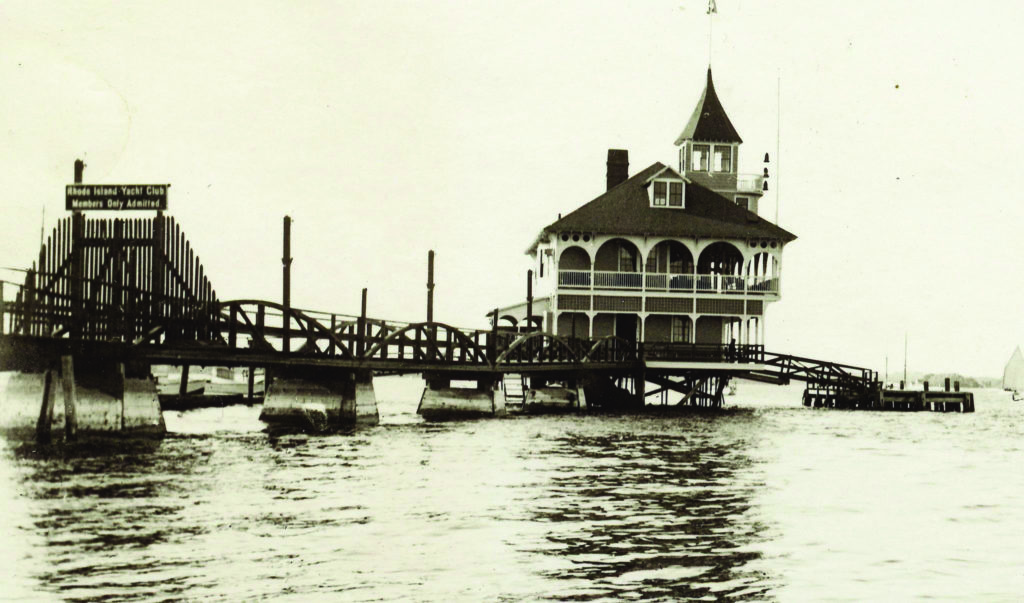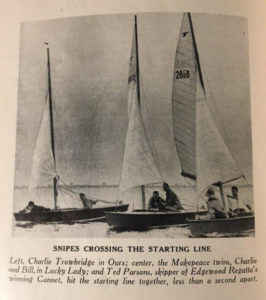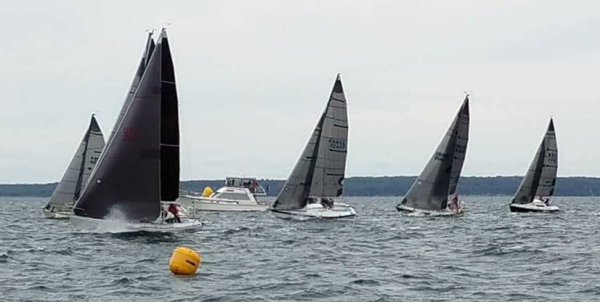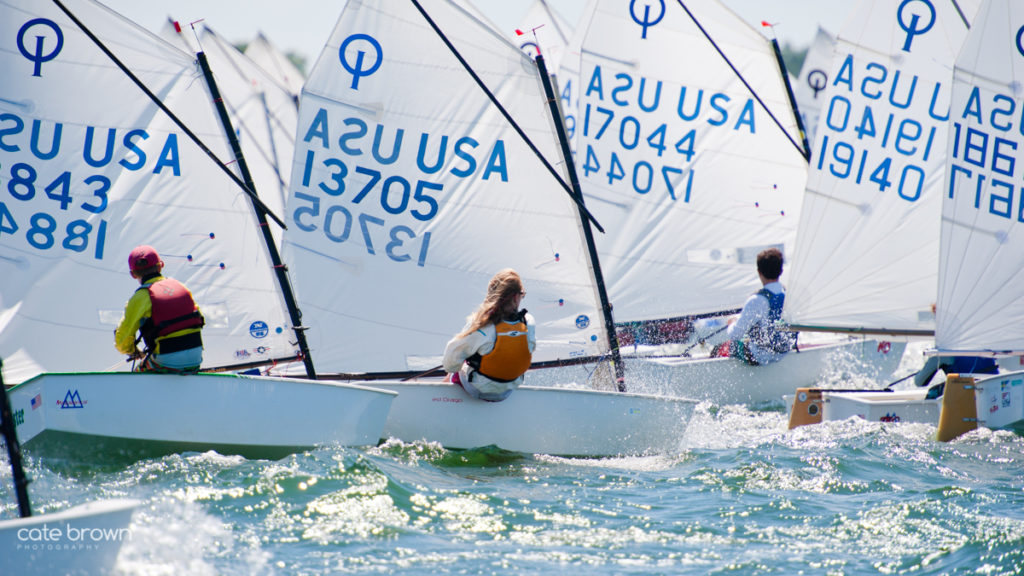In February of 1938, 12 sailors representing yachts clubs from around Narragansett Bay gathered at Rhode Island Yacht Club. RIYC was a fitting gathering place, as it was the oldest yacht club in Rhode Island – chartered in 1875 as the Providence Yacht club and renamed the Rhode Island Yacht Club in 1887. The 1887 name change coincided with the construction of an impressive clubhouse on Great Rock at Stillhouse Cove in Cranston, RI – the same site where pre-Revolutionary War Rhode Islanders brought ashore the British commander after burning the HMS Gaspee to the waterline – six months before the Boston Tea Party. The picturesque yacht club was the perfect backdrop for the birth of the NBYA (but little did these “founders” know that the building would be swept away by a 30-foot tidal surge just six months later in the infamous 1938 Hurricane).

Rhode Island Yacht Club as it looked following construction in 1887.
The purpose of this first meeting was to bring together like-minded racers from the 10 or so yacht clubs on the bay and pool efforts for hosting and running regattas. This new association was formed not only to encourage yacht racing on Narragansett Bay, but to also frame and unify the rules governing yacht racing to conform, insofar as practicable, with the rules of the North American Yacht Racing Union (NAYRU) which later became the United States Sailing Association. The first order of business was naming the group, and the Narragansett Bay Yachting Association (NBYA) was born. Jeff Davis was appointed as their first President, and William T. Bailey as Secretary.
One-design boats ruled the day back then with the Nathaniel Herreshoff-designed S-Class leading the way, along with Indians, Lightnings, Snipes, Town Class, Candys, International 110s, and Beetles.

One-design racing in Snipes.
Over time—and especially as fiberglass boats made their way onto the scene in the 1960s—mixed fleets began to supplant the one-design classes. This was particularly true for larger yachts and the new breed of cruiser/racers. This led to the creation of handicapping systems to allow for head-to-head racing between all types of boats. The CCA (Cruising Club of America), IOR (International Offshore Rule), MORC (Midget Ocean Racing for boats under 30’), IMS (International Measurement System, later known as the International Rating Certificate or IRC), and now the PHRF (Performance Handicap Racing Fleet) were just some of the handicapping systems used over the years. NBYA, like most of North America, has predominantly relied on PHRF since the 1980s.
In the 1950s and 1960s sailors would gather at one designated “host” yacht club for regattas that often drew 400+ boats of all sizes. Barrington Yacht Club often hosted these large regattas at Ohio Ledge, which turned into a popular spot due to its somewhat central location. Bristol Yacht Club and East Greenwich Yacht Club also would host large regattas in the east and west bays, regularly seeing 300-400 boats. All senior and junior racers used the same course for many years, and racing was often a family affair. It was a common sight to see a family’s mid-size cruiser towing one or two one-design dinghies to a weekend regatta. Many of these regattas were two-day events, so families often would bunk on the larger boat and then spilt-up for racing in the various fleets. A social was usually held on Saturday evenings – these were fun and memorable weekends of racing and socializing for the entire family!
As years passed the regattas began to morph. PHRF, One-design, and Junior’s all began sailing their own racecourses or multi-day regattas. However, both senior and junior events remained hugely popular, drawing large numbers of participants. Today, after more than 80 years since our founding, NBYA’s mission remains largely the same – serving as a Regional Sailing Association (RSA) for US Sailing by providing leadership, structure, and coordination of sailboat racing activities throughout Narragansett Bay and adjacent waters. This takes many forms, but none more important than hosting and supporting racing events for sailors of all ages.

Spinnaker B Class starting a recent NBYA Fall Regatta.
On the senior level, qualifying participants can earn the distinction of winning the esteemed Boat-of-the-Year (BOTY) Award. This award is sponsored by GMT Composites and goes to the best performance boat in spinnaker and non-spinnaker divisions. NBYA also hosts annual team racing – the Swanson Cup (spinnaker) and Bay Challenge Cup (non-spinnaker). Each event allows yacht clubs to assemble teams of three boats that compete in team-style windward/leeward races against other three-boat teams. This friendly rivalry between member yacht clubs results in some very spirited racing (and bragging rights for a year).
NBYA also supports – financially and logistically – the junior sailing programs that are producing our sailors of the future. The NBYA Junior Program organizes multiple bay-wide regattas for Opti’s, Lasers, and Club 420’s, as well as the annual Junior Race Week. In a typical year more than 300 junior sailors will shoot over the starting line in 80 or more races at multiple locations around the bay. NBYA also provides training and professional development for junior sailing coaches and instructors and provides race officers and judges at junior events.

Opti’s hit the starting line.
Finally, NBYA often hosts seminars or speaking programs throughout the year with notable contributors to our sport. Speakers from the recent past include Gary Jobson, Brad Read, Moose McClintock, Cam Appleton, and Charlie Enright.
NBYA has always tried to work closely with its more than 30 member yacht clubs, sailing associations, and sailing-affiliated organizations. This was never more true than during the COVID-19 pandemic of 2020. NBYA was instrumental in bringing together the clubs on the bay to share information about how to operate under the many restrictions imposed by the pandemic. The result of this cooperation was dramatic. Clubs were able to re-open and offer their members near normal but safe use of facilities. More importantly, many regattas for both seniors and juniors were held around Narragansett Bay while most other regions in the northeast cancelled such events, leaving their fleets high and dry.
Since 1938 NBYA has been a strong and vibrant organization. We continue to grow each year, with a strong membership base of those who enjoy the sport of yacht racing. We hope you will consider joining us on Narragansett Bay to enjoy the wonderful camaraderie, excellent racing, and fun events of NBYA. Learn more at www.nbya.org.
History compiled by Dave Easterbrooks and Chip Hawkins
